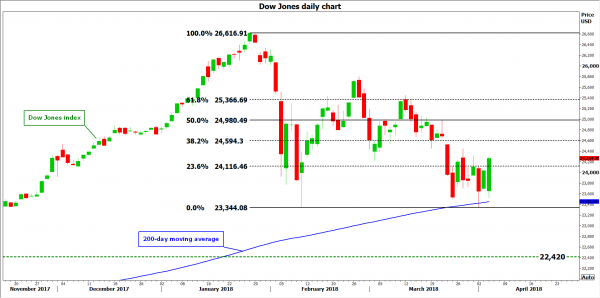Following the latest round of retaliatory tariffs by China, uncertainty is high, and the next move by either side will determine whether all these actions were just “posturing” ahead of serious negotiations, or whether the situation is set to develop into something bigger, like an actual trade war.
On Wednesday, China unveiled its second round of tariffs on US goods, marking the most significant development in the Sino-American trade dispute so far. The Asian nation announced a list of countermeasures just hours after the US unveiled details of the tariffs it will impose on Chinese technology imports. China plans to set levies on 106 US goods, among which are soybeans and aircrafts.
While it may not sound like much, the fact that soybeans are included in this list is monumental. Note that China is the world’s largest importer of soybeans, and that soybeans are America’s largest agricultural export to China by far. The fact that the Chinese are willing to play the soybean card and hurt their own interests in the process is a testament to the gravitas of the situation, and sends the message to the US that the Asian nation will not shy away from a trade standoff.
What happens next is by far the most important chapter in the trade saga. The next move by either side will determine whether all these actions were just “posturing” ahead of serious negotiations, or whether the situation is set to develop into something bigger, like an actual trade war. In other words, will the US play the retaliation game and announce new countermeasures, or will the two sides head to the negotiating table and work out their differences?
Fresh US measures would likely reinforce concerns that the situation could rapidly grow out of control. In such a case, the market reaction that ensues will likely resemble what we saw in recent days: risky assets like equities could drop further, while safe havens such as the yen may come under renewed buying interest. Looking at the Dow Jones, further declines could encounter support near the 23,344 level, which is the index’s recent low, with the area around this hurdle also encapsulating the Dow’s 200-day moving average. A downside break of that zone would mark a lower low on the daily chart, and from a technical perspective would raise the likelihood for further declines, perhaps towards the 22,420 barrier that is defined by the September 21 highs.
 On the flip side, should the two sides come to the negotiating table, then the narrative that all these actions were simply a negotiating tactic ahead of serious talks would gain traction. Expectations that the situation may remain contained and not escalate any further could help risk sentiment to rebound, leading to a recovery in stock markets and a tumble in safe-haven assets as uncertainty fades. In this case, the Dow could edge higher and initially challenge the 24,594 level, which is the 38.2% Fibonacci retracement of the January 26 – April 2 downleg. Further advances could stall near the 24,980 level and subsequently, at 25,366, which are the respective 50.0% and 61.8% retracement levels of the aforementioned downleg.
On the flip side, should the two sides come to the negotiating table, then the narrative that all these actions were simply a negotiating tactic ahead of serious talks would gain traction. Expectations that the situation may remain contained and not escalate any further could help risk sentiment to rebound, leading to a recovery in stock markets and a tumble in safe-haven assets as uncertainty fades. In this case, the Dow could edge higher and initially challenge the 24,594 level, which is the 38.2% Fibonacci retracement of the January 26 – April 2 downleg. Further advances could stall near the 24,980 level and subsequently, at 25,366, which are the respective 50.0% and 61.8% retracement levels of the aforementioned downleg.
What is more likely? On balance, the scenario for negotiations appears more realistic. Both sides want to avoid a real trade war, as it would be a lose-lose situation that harms both economies. Moreover, by this point, the US may have done enough posturing for China to make some compromises in their trading relationship, which in all likelihood, was all the US was trying to achieve in the first place. Lending credibility to this argument, is the fact that the new US National Economic Advisor, Larry Kudlow, said yesterday that there is a possibility the US tariffs may never go into effect, adding that he expects intense negotiations ahead. Of course, even if this assessment is correct, one should remain vigilant as trade negotiations are a complicated matter that could drag on for months, implying that more posturing and “trade war” headlines could show up before the situation calms down for good.













